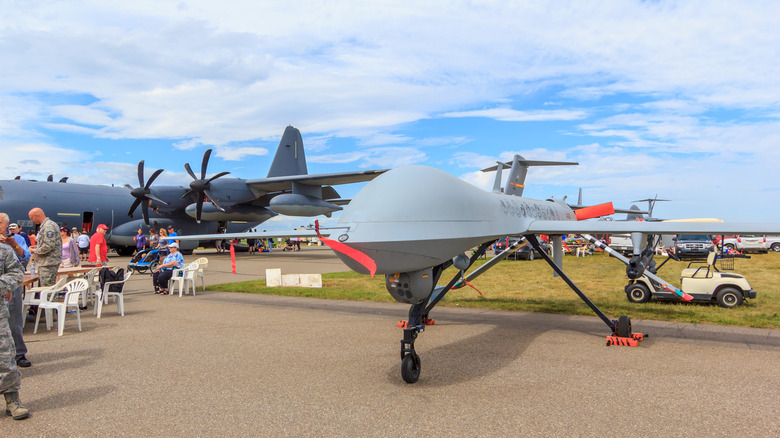
achinthamb/Shutterstock
The development of drone technology has been an enormous boon not only for film enthusiasts, scientists and commercial applications, but for the U.S. Armed Forces and other militaries around the world. They can provide impressive firepower in a small package and sometimes (but not always) a cheap one. The advantages of such applications are obvious: being remotely-operated, the risk to a pilot is greatly reduced.
Advertisement
This isn’t to say, of course that military drones are purely offensive weapons. Throughout the history of warfare, reconnaissance and transportation have been equally formidable weapons. Drones and unmanned aircraft more broadly can excel in all of these areas, which is why there’s a wide variety of them to be found deployed by the U.S. Army, Navy, Marine Corps, Air Force, and now Space Force.
The U.S. military has divided its UAS (Unmanned Aircraft Systems) repertoire into five numbered groups, separating them by their size, weight, and other capabilities. Let’s take a look at each group in turn to see how the models differ. Some models are works in progress, others are in current use and yet others have been discontinued, but all of them have been instrumental parts of a whole new kind of warfare, one that is even changing the way aircraft carriers are used.
Advertisement
Group 1: The Smallest UAVs
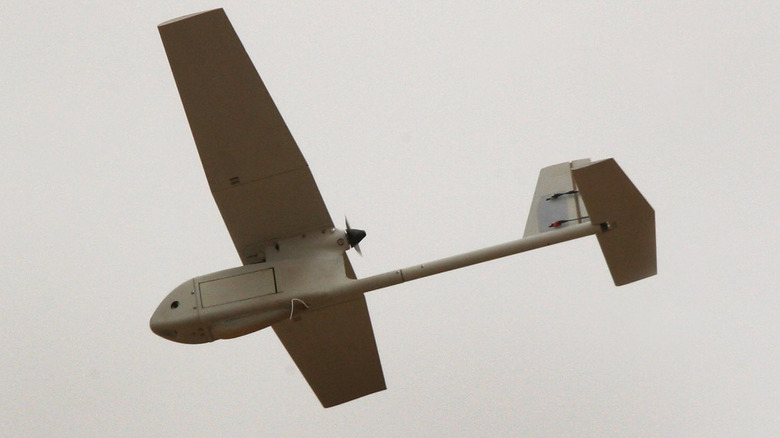
John Moore/Getty Images
The Group 1 classification for a UAS, as defined by the Department of Defense’s Unmanned Aircraft System Airspace Integration Plan, contains models that are «typically hand-launched, self contained, portable systems employed for a small unit or base security.» They generally weigh no more than 20 pounds. Typically operating within view of the pilot, they have a short range, generally flying at speed of 100 knots or less and lower than 1200 feet from the ground.
Advertisement
A prominent group 1 UAV in the U.S. arsenal is the RQ-11 Raven family. The Raven may have many of the characteristics of a remote control airplane one might fly as a hobby, being launched by hand and just three feet long with a 4.5 foot wingspan, but it’s a valuable tool in the military’s arsenal. It excels in the recon role, equipped with infrared capabilities and a 10-kilometer view.
The RQ-11 was first fielded in 2004 and the family is still used by the U.S. military, with manufacturer AeroVironment declaring it «the most widely deployed unmanned aircraft system in the world.» It blends the convenience of a rucksack-sized drone with advanced ground control links, infrared and gimbal technology allowing this discreet eye-not-very-high-in-the-sky to provide up to the minute photo and video. They can fly for approximately 75 minutes at a time, ample for close-range missions.
Advertisement
Group 2: Catapult UAVs
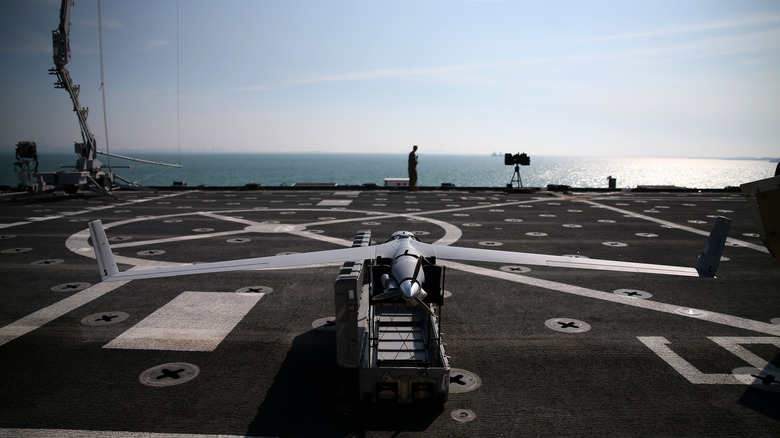
Mark Wilson/Getty Images
The Department of Defense‘s UAS Task Force notes that drones with this classification will weigh up to around 55 pounds, and have considerably more versatility in their range, being capable of flying at heights of up to around 3,500 feet. They have a very similar general role to that of smaller models like the Raven.
Advertisement
Recon and surveillance are a specialty of smaller drones in particular, and group 2’s models are well-suited to this aspect of warfare. One notable example of this second group of UAVs is the Scan Eagle, a drone introduced by Insitu (a brand purchased by aviation giant Boeing in July 2008). With a 10.2 feet wingspan, a length of 5.6 ft and the capacity to carry up to 11 lbs in cargo, the Scan Eagle is quite a sizable prospect, and it also packs some hefty surveillance equipment.
Beneath its rather simplistic looking exterior, it boasts an EO950 with an EO telescope and zoom capacity outputting at 960×720 pixels, as well as digital and analogue datalink. It’s also used to form a communication relay. The drone itself has a sizable entourage of four (two to perform maintenance on it and two to pilot it), with its increased size requiring the use of a sort of slingshot launcher to get it in the air. It communicates with systems on the ground that interpret the data it provides.
Advertisement
Group 3: The middle of the range UAVs
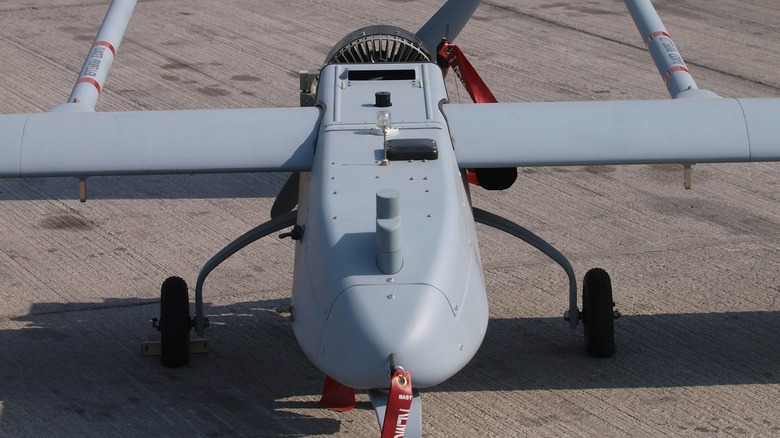
Flying Camera/Shutterstock
Group 3 models are categorized as being up to 1320 lbs in weight. They can reach up to FL (Flight Level) 180, the equivalent of approximately transition altitude, 18,000 feet, in the U.S.
An example of a group 3 UAV is the RQ-7B Shadow, a name that reflects the modus operandi of the model: To subtly and secretly see. It’s an insidious weapon that doesn’t strike the blow itself, but rather provides the location information needed by its heavy-hitting allies. It does this primarily through its connection to an Advanced Field Artillery Tactical Data System and Joint Surveillance and Target Attack Radar System. At a Fort Huachuca event marking the end of the service of the original Shadow in April 2024, aircrew training program manager Raymond Rivera explained the invaluable function the model performed: «If [the Soldier] can’t see over that hill, or around that corner, you put these systems up in the air, and they provide that for them.»
Advertisement
The Shadow v2 Block III, current model, is still in action, boasting a 20.4 ft wingspan and 535-lb maximum weight at takeoff. As a result of its size, models of this caliber require launchers using hydraulic or pneumatic power, and a Tactical Automatic Landing System to return to earth. They’re a far cry from their hand-launched little peers, but there are other much bigger UAVs and UAS still.
Group 4: The second-largest models around
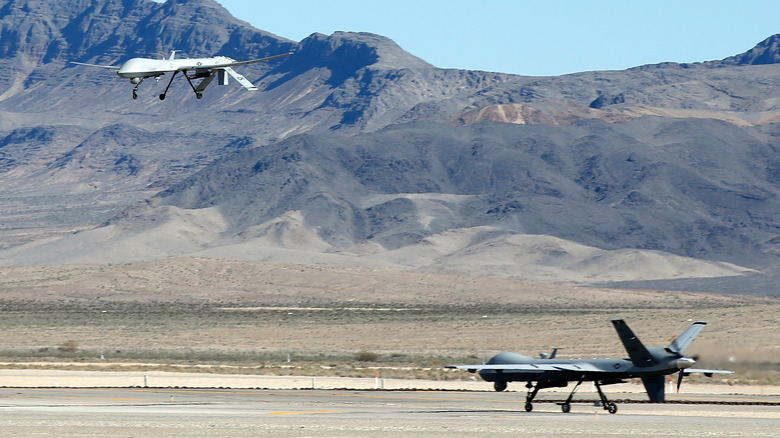
Isaac Brekken/Getty Images
Where some of the smallest UAVs are designed for similarly-small scale operations, often in view of the operator, there are some military operations that call for drones with even larger range and altitude capacity than group 3 models. Group 4, according to the unofficial designations of the Department of Defense, can weigh above 1320 lbs – the top end weight of the world’s largest land carnivore, the polar bear – but, unlike the final group, tend to be restricted to a typical altitude of less than 180 FL.
Advertisement
The speedy MQ-1B Predator, while originally intended for a supportive role like the Shadow, distinguishes itself with its ability to also wield potent firepower. A pair of Hellfire AGM-114 missiles means that it can both pinpoint targets and strike them with its own hefty projectiles. A 2,250 lb maximum weight and 55 foot wingspan demonstrates how sizable this group of UAVs can be, while its versatile 115 horsepower 914F Rotax engine, additional sensor operator and ‘M’ (Multi-Role) designation all make it clear that the model isn’t a one-function wonder, with the U.S. Air Force defining its job as being «primarily as an intelligence-collection asset and secondarily against dynamic execution targets.»
Advertisement
For practicality’s sake, multi-purpose drones such as these are common. In September 2015, the U.S. Air Force wielded 150 Predator drones. The largest UAVs, designated group 5, also tend to put firepower second, as potent as they may be in the area.
Group 5: The biggest UAVs in the business
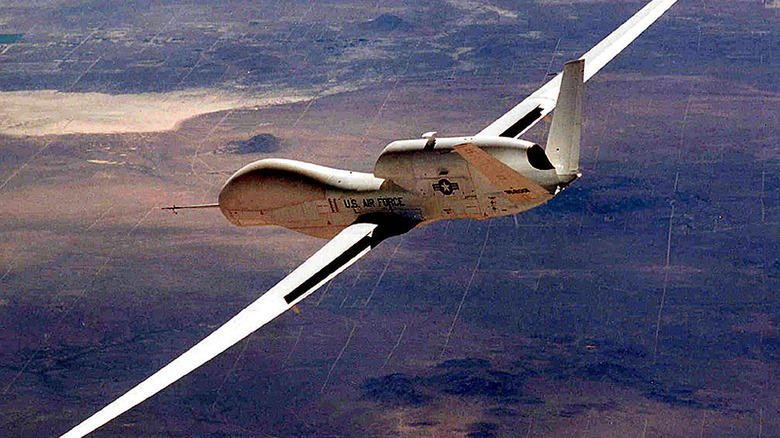
Usaf/Getty Images
Drone technology has advanced and broadened to an incredible degree. In 2017, the University of Pennsylvania’s Mark Yim introduced the smallest functional drone ever made, an adorably diminutive 39mm. At the other end of the scale, there are formidable drones like those in group 5. These machines are rather more limited in terms of how they can be deployed, as they require more space to launch, but they certainly make up for their more unwieldy nature in other respects.
Advertisement
The Global Hawk is one example of these UAVs, and it’s proven to be a potent tool indeed. Its F137-RR-100 turbofan engine offers 7,600 lbs of thrust and propels it at a speed of up to 357 mph, though it has a range of an impressive 12,300 nautical miles. The model, which was first deployed in November 2001, is not armed like some military drones, being a specialized ISR (Intelligence, Surveillance, and Reconnaissance) unit.
In the mid-2010s, the U.S. Armed Forces had 33 Global Hawks in service, and they were divided into and equipped for three specific roles. The final one, the block 30 models, were equipped with SIGINT (or Signals Intelligence) sensors on top of other advanced radar systems such as SAR, while some of those designated block 20 were instead given Battlefield Airborne Communication Node functionality, making use of the higher altitudes the model could achieve to facilitate communications that would otherwise be difficult or impossible.
Advertisement
The other types of drones used by the U.S. armed forces
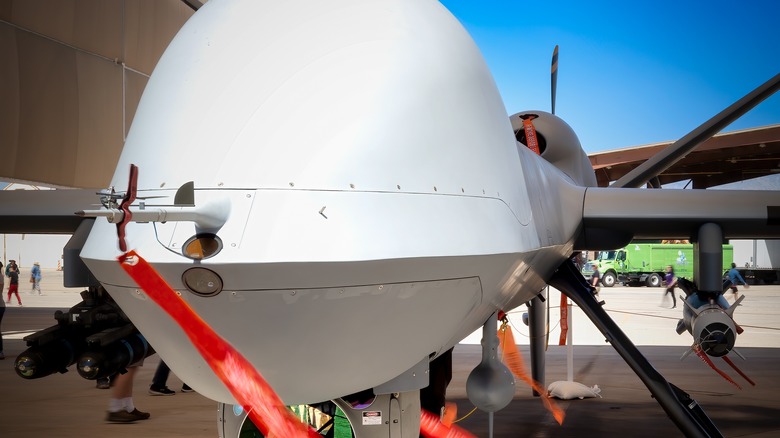
Bill Chizek/Shutterstock
The blanket of ISR covers three of the primary purposes of military drones. With sophisticated cameras and infrared or thermal capacity, they can capture the imagery and intelligence required for plotting dynamic maps of an area. Providing precise knowledge of the location of allies and opponents allows for offensive and defensive operations that would be far riskier without them.
Advertisement
Military drones can do much more, however. Where the Global Hawk doesn’t carry weapons, another group 5 model, the forebodingly-named Reaper, has more of an offensive design. With a wingspan just short of 70ft and at 36ft long and 12 ft high, it’s an imposing machine, far from what civilians would typically think of on hearing the word ‘drone.’ To emphasize this aspect of the aircraft, it can also be equipped with Hellfire missiles: A quartet of them, no less. To further bolster its effectiveness against a wider range of targets, it also has the capacity to wield two hefty GBU-12 bombs. GBU-12s, too, offer laser precision, allowing the Reaper to use its extensive sensor equipment, including infrared, SAR, and its cameras, to instigate carefully targetted and potent attacks.
Advertisement
The model, also wielded by the British Royal Air Force, is a perfect fit for Target Acquisition missions and was created with offense firmly in mind. Set to be replaced by the upcoming hybrid electric MQ-NEXT, the Reaper has been one of the United States military’s most advanced drones.
The history of U.S. armed forces military drones
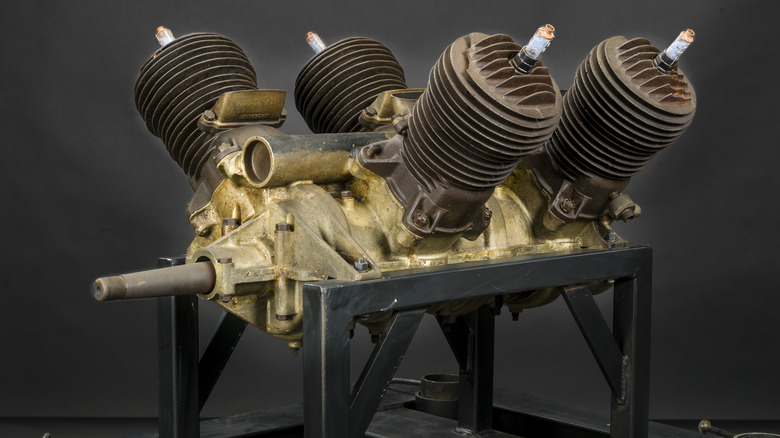
Heritage Images/Getty Images
The virtues of drones for reconnaissance and intelligence-gathering purposes are obvious, offering a valuable vantage point from which to safely gather information. It’s no surprise, then, that the earliest experiments with military drones had a heavy focus on these applications. This isn’t to say that they weren’t also envisioned as missile-like flying weapons from the beginning, though: The so-called Kettering Bug, developed by Charles F. Kettering of General Motors and C.H. Willis of Ford Motors in 1918, could be considered one of the very first ‘drones.’ It was a U.S. creation powered by a V4 DePalma engine (pictured here), dreamed up in response to the U.S. army’s call for a flying explosive. Ultimately, the motor vehicle heavyweights’ creation wouldn’t get past the testing stage, but the basic concept behind it would, in a roundabout way, lead to the development of today’s sophisticated models.
Advertisement
In terms of unmanned surveillance aircraft, the Vietnam War saw the United States’ first large-scale deployment of models such as the Ryan Model 147, itself adapted from the earlier Ryan Firebee. David Axe’s «Drone War Vietnam» explains the utility of such devices during this 1960s-defining conflict: «drone aircraft spotted targets for manned U.S. bombers, jammed North Vietnamese radars and scattered propaganda leaflets, among other missions.» The J69-T-69-equipped 147 was launched by a helicopter and could be retrieved in the same manner. It utilized wire mesh and inserts on its fiberglass body to make it more difficult to detect.
Discontinued U.S. military drones
Though the latest variants of models like the Reaper and Raven are still used by the U.S. military, the years have also seen more recent retirements in the area than that of the century-old experimental Kettering Bug. Another model that used fiberglass in its construction to aid in its evasion of opposing radar was the RQ-2A Pioneer, which was used in another prominent U.S. conflict: the Gulf War.
Advertisement
This model was created as a follow-up to the Scout, a surveillance UAV that had been created by Israel Aircraft Industries in the 1980s. The U.S. Navy was the first to wield it, and it was supported by a Portable Control Station and Ground Control Station to best utilize the information it could gather during its 5.5 hour (at max) missions. The successful Pioneer was retired in 2007, and was enormously influential. In the midst of Operation Desert Storm, Major «Pioneer demonstrated to senior leaders how RPAs could effectively complement other information systems, providing a total battle space view to all commanders,» Air Force Maj. Richard Major wrote in 2012’s «RQ-2 Pioneer: The Flawed System that Redefined U.S. Unmanned Aviation.» It arrived at a pivotal time and performed a pivotal role.
Advertisement
According to Major, the year of the Pioneer’s retirement saw the UAV Roadmap report from the Defense Department explicitly note that the model’s performance was «the reason why there were follow on RPA systems like Predator and Global Hawk.» What a legacy.
[Image by U.S. Navy via Wikimedia Commons | Cropped and resized | Public Domain]